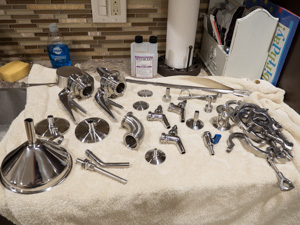
This week I dive into the cleaning process and discuss some of the most popular cleaners used when brewing beer. Last week in Part 1, I explained why cleaning and sanitation is so important for beer and discussed environmental concerns such as where to locate your brewery.
As I discussed in part 1, cleaning and sanitation are two separate steps done to make sure your equipment is free of soil and that microorganisms and bacteria are reduced to a level where they don’t interfere with the fermentation or long term stability of the beer. You want to clean all of your equipment after you use it and you should also clean it again before you brew to remove any soils that have accumulated since your last batch.
Cleaning Your Equipment
Cleaning removes soil from the equipment. Soil comes in two types: organic and inorganic. Organic soils include bits of grain, yeast, wild yeast, and other living debris from a surface. These can be left either from previous brewing sessions or dirt and dust present in the environment. Inorganic soils include raw dirt and dust as well as harder minerals like beer stone which forms at the bottom of your boiler when you brew.
While household cleaners can be used, they are often not ideal for brewing. Many household cleaners contain scents and oils that can be left on equipment after cleaning. Also while many do a good job with organic soils, they are often not designed to remove inorganic soils such as beer stone from equipment. Use a good alkaline cleaner that is designed for beer brewing if possible.
Popular Brewing Cleaners
- Household Detergents/Dish Soap – These are probably not your best option for cleaning equipment. Unfortunately many dish soaps contain perfumes and oils that can leave a film on the surface after rinsing. They are usually not formulated to remove inorganic soils like beer stone as well. I would only use household soap on an Aluminum pot, and that’s due to the fact that the alkaline cleaners listed below will oxidize aluminum.
- Bleach (Sodium Hypochlorate) – While bleach is often used by home brewers for sanitization, its not really ideal for removing soils. It also can break down plastics over time as well as stainless steel.
- Oxi-Clean or One Step (Sodium Percarbonate) – These are oxidizers that break down into sodium carbonate and hydrogen peroxide when dissolved in water. Many of you are probably familiar with hydrogen peroxide for medical use. These are effective and environmentally friendly cleaning agents, though you need to make sure you get the “scent free” version of Oxiclean if you go that route.
- TSP (Tri-Sodium Phosphate) – An effective cleaner, though semi-caustic. While recommended by some manufacturers for passivating new stainless steel equipment, there are probably better options for that purpose. As a cleaner, it is effective, but it is a harsh acid that can etch some materials, burn your hands if not careful, and also phosphate is not considered good for the environment.
- Caustic Cleaners (Lye or Sodium Hydroxide) – Though caustic cleaners are widely used in commercial brewing, they are not a good choice for home brewing as they can easily burn your skin and lead to injury. Commercial systems are set up with touch-free systems to handle the caustic chemicals, but home brewers should look for safer options.
- Powdered Brewery Wash (PBW) – Probably the most popular option for home brewers, PBW is effective on both organic and inorganic soils, and also safe and easy to use. A short soak and light brushing will remove almost all of the soils common to brewing.
I personally prefer to use cleaners designed for brewing as they do the best job cleaning both organic and inorganic soils, and the price is not excessive.
I hope you enjoyed this week’s article on cleaners for beer brewing. Next week in Part 3 I will focus on popular sanitizers. Please subscribe for regular weekly delivery, and don’t hesitate to retweet, link, like or mention any of my articles on social media.